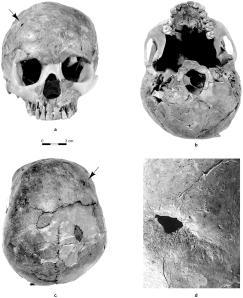On Friday I write shorter posts about research into human evolution that is interesting, but doesn’t contain quite enough content to sustain a longer article. Except I keep finding interesting discoveries that are still too short even for this format. So I thought I’d group a bunch of them together into a “this week in EvoAnth” style post. The first few will include older stories as I work through my backlog, but hopefully they’ll become more topical over time. As always, feel free to leave any suggestions for improvements; or maybe point out a topic you’d like to see more on.
Admin over, here is the first edition of “this week in EvoAnth”; for the week starting 4/8/14. And covering news from before that date.
-

The Qafzeh 11 skull. The arrow points to the head trauma
Violence in the Middle East may have a very long history. Qafzeh 11, a 90,000 year old human from Galilee, has been identified as the first person in the region to suffer head trauma. The wound didn’t kill them – although did appear to stunt their brain growth and may have resulted in neurological disorders – and they managed to survive a few more years until eventually dying at around age 13. Although consistent with assault, accident can’t be ruled out as a cause. Qafzeh 11 appears to have been given a ceremonial burial by their tribe (source).
- New fossils have been discovered belonging to the oldest Australopithecine: Australopithecus anamensis, which dates to around 4 million years ago. These fossils include parts of their body never before discovered, which is handy, but they don’t really change our understanding of the species as everything fits within the range of previously discovered fossils. Nevertheless, the discovery of another individual with these characteristics confirms that Australopithecus anamensis is really a distinct species (source).
- Narikotome boy is one of the more complete fossils of Homo erectus ever found. However, despite years of study there are several strange things about it. It’s hard to figure out how old he was (with estimates ranging from 7 – 14 years old) and he appears to have been freakishly tall with some strange asymmetries and deformaties. New research may have figured out why he had some of these weird features: he suffered from scoliosis; a type of spinal deformity (source).
- Atapuerca is an important Spanish site that documents human evolution in Europe. It reveals our family abandoned the continent around 700,000 years ago. Now new dates from the site have helped pinpoint when we return. Optically-stimulated luminescence dating (OSL) suggests this “second wave” of hominins had returned to the site by around 433,000 years ago. OSL dating works by (as the name suggests) “stimulating” samples with light. Their response corresponds to how long its been since they were last exposed to light (i.e. how long they’ve been buried) (source).
And of course, let’s not forget the news stories I did cover in more detail.
- New research suggests that humans, rather than the ice age, may have been responsible for the extinction of mammoths and other megafauna. More than 70% of large mammals went extinct in some places over the past 100,000 years; and it seems like we might be to blame after all.
- Evolutionary psychologists argue humans still engage in “courtship feeding”, with people ranking interactions that involve sharing food as more intimate than those without it. However, their research suffers from a massive case of congruance bias.

